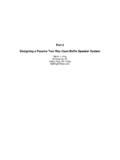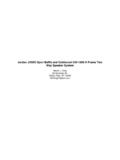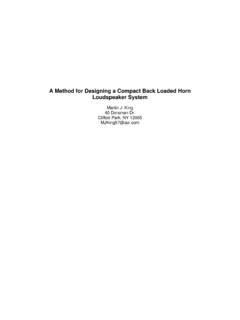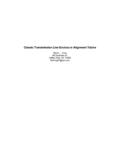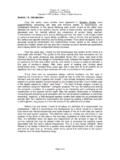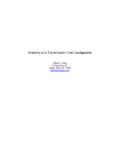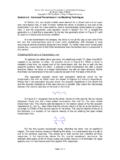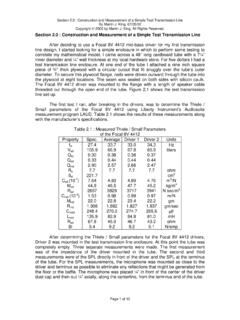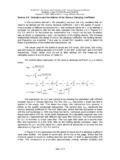Transcription of Part 1 Designing a Passive Two Way Open Baffle …
1 part 1. Designing a Passive Two Way open Baffle Speaker System Martin J. King 40 Dorsman Dr. Clifton Park, NY 12065. part 1 : Designing a Passive Two Way open Baffle Speaker System By Martin J. King, 09/15/07 (revised 09/17/07). Copyright 2007 by Martin J. King. All Rights Reserved. Introduction : A search of the Internet will reveal that there are a number of commercially available open Baffle , hence forth abbreviated as OB, dipole speaker systems available in the audio marketplace. Offerings such as Seigfried Linkwitz's Orion(1), John Kreskovsky's NAO(2), and Paul Hilgeman's Ronin(3) can all be characterized as floor standing narrow Baffle dipole speaker systems. Each features active crossovers and EQ.
2 Filters requiring at least two amplifiers. These are all very sophisticated well engineered designs that allow the use of a narrow Baffle while still producing satisfying bass output. The key to these designs is the use of active crossovers and EQ filters to produce sufficient low frequency output. Some examples of OB speaker systems that use Passive crossovers are Danny Richie's OB-5 and OB-7(4), the Jamo R 909(5) and Hawthorne Audio's Solo(6). These are also narrow, at least when considering some of the woofer diameters, OB speaker systems that claim bass performance down into the 25 - 30 Hz range. Being Passive crossover designs, these speakers do not have requirements for sophisticated electronic filters and multiple amplifiers.
3 Instead they rely on the acoustics of the Baffle and a Passive crossover to generate a balanced SPL frequency response. While the cost of multiple amplifiers is no longer a factor in these designs, the most expensive of all the OB speakers mentioned is the Jamo R 909 speaker system which on sale is still $7500. (the list price is approximately $13,000). Even though I have not heard any of these OB speaker systems, I am sure the performance of each is outstanding and easily justifies the cost. But the combination of a Baffle 's acoustic design and a Passive crossover, as used in the Jamo R 909, to tune the bass response was just too intriguing for me not to try and understand the trade-offs. Reading the online copy of a Jamo R 909 white paper started me thinking about how to achieve this simple yet elegant design concept.
4 As a first step I have performed a design study, using some of the concepts learned from studying the Jamo white paper and owner's manual, for a Passive two way OB system that is very modestly priced. This design study is discussed on the following pages. The next logical step would be to design a bigger all Passive crossover three way OB speaker system. That may be the topic of a future study, project, and document. DIYer Designs on the Net : Looking around the Internet for DIYer designs of OB speakers yields a wide variety of different Baffle sizes, Baffle shapes, number of drivers, types of drivers, and Passive or active crossovers being used. The level of sophistication in the design process spans from a trial and error design based on experience/experimentation all the way up to a design based completely on computer simulation predictions of SPL.
5 Response curves. Both methods work and can generate finished OB speaker designs with exceptional performance. The design of an OB speaker system can be as quick and easy as constructing a temporary Baffle from cardboard, listening to the response, and making immediate adjustments to address shortcomings in what the designer/builder hears. Quick, easy to build, and cheap are all appealing attributes of OB systems for a lot of DIY speaker builders. Page 1 of 15. part 1 : Designing a Passive Two Way open Baffle Speaker System By Martin J. King, 09/15/07 (revised 09/17/07). Copyright 2007 by Martin J. King. All Rights Reserved. An OB speaker system is a fairly forgiving design where probably the worst possible outcome is disappointing bass performance.
6 But additional bass response can be added later with a dedicated subwoofer so a fix is fairly easy. The drivers produce SPL frequency responses consistent with manufacturer's specification sheets without any interaction with a tuned enclosure. The Baffle itself tends to only roll off the driver's lowest frequencies starting at a frequency value determined by the physical size and shape of the Baffle . Without the potential for mistuning an enclosure, the resulting booming or anemic bass performance problems of boxed speakers are avoided. A compromise position between a completely experimental design method and a completely computer simulation based design method is the use of tools like the EDGE(7).
7 Computer program. The EDGE program helps define the influences of the Baffle 's size and shape on the system's low frequency response. Using a Baffle response calculator, like the EDGE, does not factor in the influence of the driver's response so it is only one piece of the puzzle. Sometimes the other puzzle pieces are neglected when the DIY. designer focuses solely on the calculated Baffle response. Using programs like the EDGE requires the designer to somehow sum the Baffle 's response with the speaker's response to generate the system's response. In my opinion, too much emphasis is sometimes placed on the calculated Baffle response curves without considering the complex summation that needs to occur to produce the complete system response.
8 I really like full range drivers and the lack of a crossover in the midrange frequencies, so I am going to slant this approach to the use of full range drivers as wide band devices with the bass reinforced by an additional driver. In my opinion, there is no affordable single full range driver available that can be mounted in a reasonably sized OB speaker system and still reproduce balanced bass, midrange, and treble responses. While the midrange can be handled nicely by a single full range driver in an OB, one end or maybe both ends of the audio spectrum will be compromised. Therefore, for this study the bass performance requirement will be met by using a woofer driver that is crossed over between 100 and 200 Hz to the full range driver.
9 Selecting Drivers : In the design of multi-way OB speaker systems using Passive crossovers, I have not seen a method presented for selecting bass and full range drivers that will assure a smooth and balanced SPL response. Therefore, a method for selecting the appropriate bass driver for a particular Baffle size and shape so that the combined efficiency matches the full range driver's midrange efficiency will be presented. The starting point is the full range driver; the efficiency of the midrange frequencies sets the requirement for the entire system SPL response. To begin the design process, we need to first define the desired end result. For an OB speaker system the bass will roll-off at a rate of 18 dB/octave, this is the sum of a 12 dB/octave roll-off for the driver and a 6 dB/octave roll-off for the open Baffle .
10 If we assume an efficiency target, a goal function can be constructed. Figure 1 depicts a 90. dB/W/m goal function, tuned to 45 Hz, which will be assumed for this sample OB design. This 90 dB response is to be achieved at a one meter distance along the axis of the full range driver. The full range driver will be located 32 inches above the floor which is approximately at ear level when seated. There is nothing magical about this goal function other then the efficiency being consistent with the selection of the full range driver. A different efficiency, tuning frequency, or listening position could just as easily Page 2 of 15. part 1 : Designing a Passive Two Way open Baffle Speaker System By Martin J.
